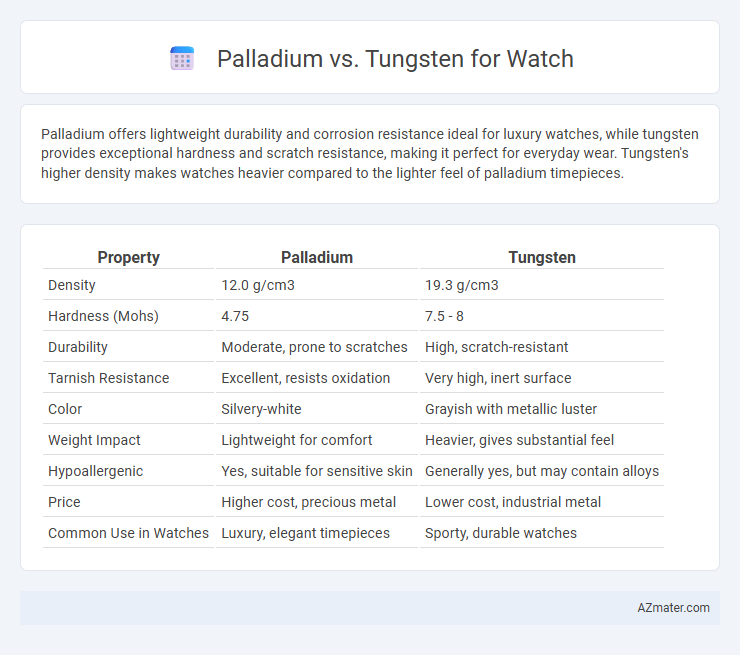Palladium offers lightweight durability and corrosion resistance ideal for luxury watches, while tungsten provides exceptional hardness and scratch resistance, making it perfect for everyday wear. Tungsten's higher density makes watches heavier compared to the lighter feel of palladium timepieces.
Table of Comparison
| Property | Palladium | Tungsten |
|---|---|---|
| Density | 12.0 g/cm3 | 19.3 g/cm3 |
| Hardness (Mohs) | 4.75 | 7.5 - 8 |
| Durability | Moderate, prone to scratches | High, scratch-resistant |
| Tarnish Resistance | Excellent, resists oxidation | Very high, inert surface |
| Color | Silvery-white | Grayish with metallic luster |
| Weight Impact | Lightweight for comfort | Heavier, gives substantial feel |
| Hypoallergenic | Yes, suitable for sensitive skin | Generally yes, but may contain alloys |
| Price | Higher cost, precious metal | Lower cost, industrial metal |
| Common Use in Watches | Luxury, elegant timepieces | Sporty, durable watches |
Introduction to Palladium and Tungsten in Watchmaking
Palladium, a rare and lustrous member of the platinum group metals, is prized in watchmaking for its hypoallergenic properties, resistance to tarnish, and lightweight feel, making it ideal for luxury timepieces. Tungsten, known for its exceptional hardness and scratch resistance, offers superior durability and a sleek metallic gray finish, often favored for robust and modern watch designs. Both metals enhance watch performance and aesthetics, with palladium focusing on elegance and tungsten on resilience.
Physical Properties: Palladium vs Tungsten
Palladium exhibits a density of 12.0 g/cm3 and a hardness of 4.75 on the Mohs scale, offering lightweight and scratch-resistant properties ideal for elegant watch designs. Tungsten, with a significantly higher density of 19.25 g/cm3 and a hardness of 7.5 to 8, provides exceptional durability and resistance to wear, making it perfect for rugged, long-lasting timepieces. Both metals offer distinct physical advantages, with palladium favoring comfort and tarnish resistance, while tungsten excels in hardness and scratch resistance.
Aesthetic Differences: Appearance and Finish
Palladium offers a bright, silvery-white appearance with a subtle sheen that maintains its luster over time, providing a sleek and modern finish for watches. Tungsten features a darker, gunmetal-gray tone with a unique, highly polished finish that emphasizes durability and scratch resistance while giving watches a bold, contemporary look. The choice between Palladium and Tungsten for watch aesthetics depends on preference for either a luminous, classic shine or a robust, industrial style finish.
Durability and Scratch Resistance
Palladium offers excellent corrosion resistance but is softer and more prone to scratches compared to tungsten, which boasts superior hardness and exceptional scratch resistance, making it ideal for everyday wear. Tungsten's durability ensures that watch surfaces remain pristine over time without extensive maintenance, while palladium requires more care to maintain its luster. For watch enthusiasts prioritizing long-lasting, scratch-resistant materials, tungsten is the preferred choice, especially in rugged or high-activity environments.
Weight and Comfort on the Wrist
Palladium watches offer a lightweight feel, typically around 12 g/cm3, making them highly comfortable for extended wear compared to tungsten, which has a much higher density of approximately 19.3 g/cm3. The lighter nature of palladium reduces strain on the wrist, ideal for those seeking daily comfort without sacrificing luxury. Tungsten's heavier weight provides a substantial, solid feel but may cause discomfort during prolonged use, especially for users with smaller wrists.
Hypoallergenic Qualities and Skin Compatibility
Palladium is highly valued for its hypoallergenic properties, making it an excellent choice for watch cases and bands for individuals with sensitive skin or metal allergies, as it rarely causes irritation or allergic reactions. Tungsten, while extremely durable and scratch-resistant, can sometimes cause skin sensitivity due to the presence of cobalt binders in some tungsten alloys, which can trigger allergic responses. Watches made from pure or hypoallergenic tungsten composites are becoming more available, but palladium remains the superior option for guaranteed skin compatibility and comfort.
Price Comparison and Market Value
Palladium watches generally command higher prices than tungsten models due to palladium's status as a rare and precious metal with significant investment appeal. Tungsten watches, while more affordable, offer exceptional hardness and scratch resistance but hold lower market value compared to precious metals like palladium. The price disparity reflects palladium's volatility and demand in the luxury market, whereas tungsten provides a budget-friendly option with durability benefits.
Maintenance and Long-Term Care
Palladium watches require minimal maintenance due to the metal's natural resistance to tarnish and corrosion, making them ideal for individuals seeking low long-term care. Tungsten watches, while highly scratch-resistant and durable, can be prone to brittleness and may require careful handling to avoid cracking or chipping over time. Both metals benefit from regular gentle cleaning and proper storage, but palladium offers superior ease of upkeep for maintaining a polished appearance.
Popular Watch Brands Using Palladium and Tungsten
Palladium and tungsten are prized metals in luxury watchmaking, each offering unique durability and aesthetic qualities. Popular watch brands such as Cartier and Piaget often utilize palladium for its lustrous, white-metal finish and hypoallergenic properties, making it ideal for elegant, high-end timepieces. Tungsten, favored by brands like Breitling and Rado, is renowned for its exceptional hardness and scratch resistance, providing a modern, robust look popular in sports and contemporary watches.
Choosing the Best Material: Palladium or Tungsten for Your Watch
Palladium offers a lightweight, hypoallergenic option with a naturally white luster that resists tarnishing, making it ideal for luxurious, comfortable watches. Tungsten is renowned for its exceptional hardness and scratch resistance, ensuring durability and a sleek, modern appearance that withstands daily wear. Choosing between palladium and tungsten depends on prioritizing either elegance and comfort or toughness and longevity in your watch material.

Infographic: Palladium vs Tungsten for Watch
 azmater.com
azmater.com